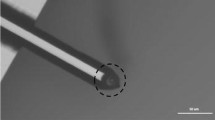Abstract
Biofilm formation on metallic surfaces in marine and freshwater environments often precedes corrosion and other biofouling conditions. Attachment is mediated by such environmental factors as the presence of surface conditioning films, fluid dynamics, bulk-phase nutrient levels, and surface chemistry. In this study, we utilized a Fowler Cell Adhesion Measurement Module to demonstrate that the changes in cellular concentration and composition of a monoculture ofPseudomonas atlantica biofilms on stainless steel were a function of the applied shear force. At shear forces in the range of 3–10 dynes cm−2 (1.0 liter min−1), attachment as measured by acridine orange direct microscopic counts was greatest at the higher shear forces.14C-Acetate uptake activity on the stainless steel surfaces increased with shear stress. Acetate incorporation ranged from 1×10−5 to 19×10−5 μmol cm−2 between 0.15 and 30 dynes cm−2 for 30 min uptake periods. On a per cell basis, however, activity decreased with shear, indicating a shift in metabolism. Fourier transform infrared spectroscopy revealed that protein and carbohydrate concentrations also increased with the applied shear. Increased biofilm C∶N ratios and total fatty acids were associated with the higher shear stresses. Neither radius of interaction nor biofilm age appeared to significantly influence the relationship between fluid shear and attachment and cellular composition ofP. atlantica biofilms in the range of 1–10 dynes cm−2.
Similar content being viewed by others
References
Absolom DR, Lamberti FV, Policova Z, Zingg W, van Oss C, Neumann AW (1983) Surface thermodynamics of bacterial adhesion. Appl Environ Microbiol 46:90–97
Bligh EG, Dyer EJ (1959) A rapid method of total lipid extraction and purification. Can J Biochem Physiol 37:911–917
Bowen BD, Epstein N (1979) Fine particle deposition in smooth parallel-plate channels. J Coll Inter Sci 72:81–97
Brown CM, Ellwood DC, Hunter JR (1977) Growth of bacteria at surfaces: Influence of nutrient limitation. FEMS Microb Lett 1:163–166
Characklis WG, Cooksey KE (1983) Biofilms and microbial fouling. Adv Appl Microbiol 29:93–138
Costerton JW, Cheng K-J (1985) Phenomena of bacterial adhesion. In: Savage DC, Fletcher M (eds) Bacterial adhesion: Mechanisms and physiological significance. Plenum Press, NewYork, pp 3–43
Costerton JW, Lashen ES (1984) Influence of biofilm on efficacy of biocides on corrosion-causing bacteria. Materials Performance 23(2):13–17
Duddridge JE, Kent CA, Laws JF (1982) Effect of surface shear stress on the attachment ofPseudomonas fluorescens to stainless steel under defined flow conditions. Biotech Bioeng 24:153–164
Fletcher M (1988) Attachment ofPseudomonas fluorescens to glass and influence of electrolytes on bacterium-substratum separation distance. J Bacteriol 170:2027–2030
Fowler HW, McKay AJ (1980) The measurement of microbial adhesion. In: Berkeley RCW, Lynch JM, Melling J, Rutter PR, Vincent B (eds) Microbial adhesion to surfaces. Harwood, Chichester, pp 143–161
Marmur A, Ruckenstein E (1986) Gravity and cell adhesion. J Coll Int Sci 114:261–266
Marshall KC (1988) Adhesion and growth of bacteria at surfaces in oligotrophic environments. Can J Microbiol 34:503–506
Nichols PD, Henson JM, Guckert JB, Nivens DE, White DC (1985) Fourier transform-infrared spectroscopic methods for microbial ecology: Analysis of bacteria, bacteria-polymer mixtures and biofilms. J Microbiol Meth 4:79–94
Peterson GL (1977) A simplification of the protein assay of Lowry which is more generally applicable. Anal Biochem 83:346–351
Ringelberg DH, Davis JD, Smith GA, Pfiffner SM, Yates P, Kampbell DH, Reed HW, Stocksdale TT, White DC (1988) Validation of signature phospholipid fatty acid biomarkers for alkane-utilizing bacteria in soils and subsurface aquifer materials. FEMS Microb Ecol 62:39–50
Rosenberg M, Kjelleberg S (1986) Hydrophobic interactions: Role in bacterial adhesion. In: Marshall KC (ed) Advances in microbial ecology, vol 9. Plenum Press, New York, pp 353–393
Rutter P, Leech R (1980) The deposition ofStreptococcus sanguis NCTC 7868 from a flowing suspension. J Gen Microbiol 120:301–307
Savage DC (1980) Adherence of normal flora to mucosal surfaces. In: Beachey EH (ed) Bacterial adherence, receptors and recognition, vol 6. Chapman and Hill, London, pp 33–59
Sly LI, Hodgkinson MC, Arunpairojana V (1988) Effect of water velocity on the early development of manganese-depositing biofilm in a drinking-water distribution system. FEMS Microb Ecol 53:175–186
Tunlid A, Ringelberg D, Low C, Phelps TJ, White DC (1989) Analysis of phospholipid fatty acids from bacteria at picomolar sensitivities from bacteria in environmental samples. J Microbiol Meth 10:139–153
van Loosdrecht MCM, Lyklema J, Norde W, Zehnder AJB (1989) Bacterial adhesion: A physiochemical approach. Microb Ecol 17:1–15
Venosa AD (1975) Lysis ofS. natans swarm cells byBdellovibrio bacteriovirus. Appl Microbiol 29:702–705
White DC, Davis WM, Nickels JS, King JD, Bobbie RJ (1979) Determination of the sedimentary microbiological biomass by extractable lipid phosphate. Oecologia 40:51–62
Young LY, Mitchell R (1972) The role of chemotactic response to primary microbial film formation. In: Acker RF (ed) Proc Third Int Congr Mar Corrosion Fouling. Northwestern Univ Press, Evanston, IL, pp 617–624
Zobell CE (1943) The effect of solid surfaces on bacterial activity. J Bacteriol 46:39–56.
Author information
Authors and Affiliations
Rights and permissions
About this article
Cite this article
Mittelman, M.W., Nivens, D.E., Low, C. et al. Differential adhesion, activity, and carbohydrate: Protein ratios ofPseudomonas atlantica monocultures attaching to stainless steel in a linear shear gradient. Microb Ecol 19, 269–278 (1990). https://doi.org/10.1007/BF02017171
Issue Date:
DOI: https://doi.org/10.1007/BF02017171




